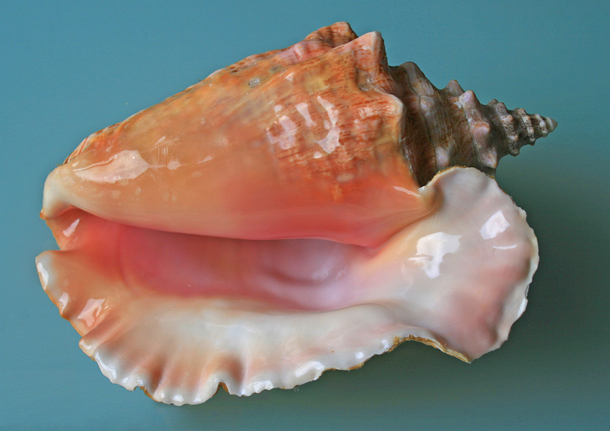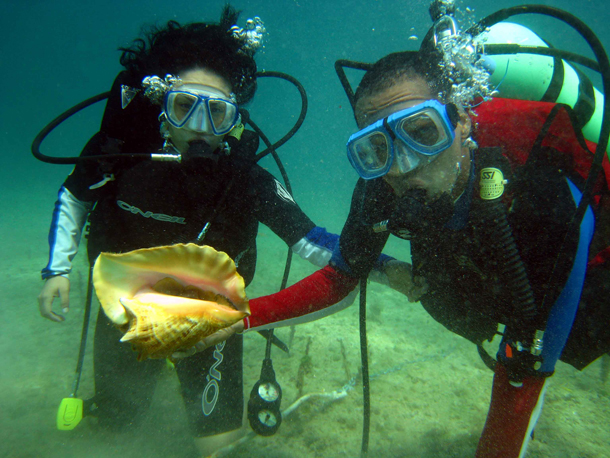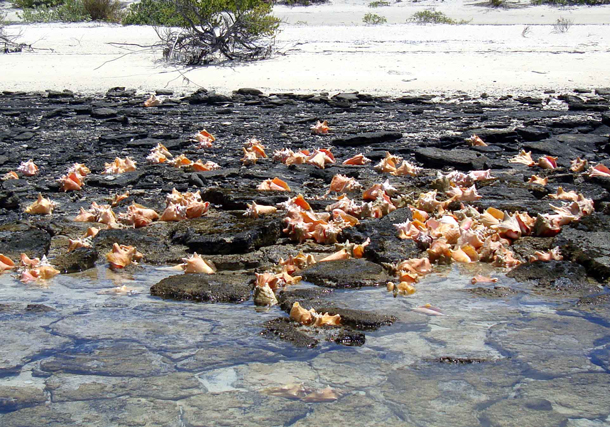Conch at the Edge
Air Date: Week of August 31, 2018

The Queen Conch is a large marine mollusk found throughout the Caribbean. (Photo: Wikimedia Commons)
The Queen Conch is a large marine mollusk with a beautiful shell that is prized for export and even adorns the coat of arms for the Bahamas. The gastropod inside the shell is featured on menus across the Caribbean. Conch is so desired and desirable that, as Living on Earth’s Bobby Bascomb reports it is in danger of being loved to death.
Transcript
BASCOMB: The Queen conch is a massive mollusk that grows an impressive and lovely spiral shell with a wide flaring lip and a bright pink interior. Conch are ubiquitous across the Caribbean, the decorative shells are exported and made into jewelry, and the huge gastropod inside is a staple food there. But I discovered new research that suggests that the conch is possibly being loved to death.
[SOUND OF CONCH SHELL BEING BLOWN]
BASCOMB: Learning to produce a musical note out of a conch shell is a desirable skill across the Caribbean. In Key West, Florida – known locally as the capital of the Conch Republic – people come out in droves to compete in the annual conch honk. Children make their best effort – they blow into one end of the huge shell that can weigh up to 5 pounds.
[SMALL CONCH SOUND, AUDIENCE CHEERS]
ANNOUNCER: Beautiful, very good Luna. Good job!

Researchers dive to collect data on conch in the Caribbean. (Photo: Community Conch)
BASCOMB: But a middle age man in a bright pink t-shirt knocks it out of the park.
[CONCH MUSIC, APPLAUSE AND SHOUTS]
BASCOMB: This year’s conch honk even involved a marriage proposal. Mary Lou Smith took her turn on stage wearing a lei and flowered dress, then a man in a matching lei and flowery shirt got down on one knee with a ring in one hand and a conch shell in the other.
MAN: Mary Lou, we’ve been together long enough for me to know that I want you for the rest of my life. Will you marry me?
[AUDIENCE APLAUDS]
BASCOMB: She responded appropriately for a conch-blowing contest.
[MARY LOU BLOWS THE CONCH]
ANNOUNCER: I think that was a yes!
[CHEERING AND CONCH SOUNDS FADE UNDER NEXT GRAPH]
BASCOMB: Conch are also a local delicacy. As for how to prepare it, the list is as long as Bubba’s ways to prepare shrimp in the movie Forrest Gump. There’s…. cracked conch, conch chowder, conch fritters, conch salad, conch and rice – you get the idea…

Researchers measure discarded conch shells to see what size animals fisherman are harvesting. (Photo: Community Conch)
As beloved as it is though, the conch fishery in the Florida Keys has actually been closed since 1975. So all of the conch enjoyed in the Conch Republic has to be imported, mostly from the Bahamas. Alan Stoner, chief scientist with the conservation organization, Community Conch, has been conducting surveys of conch populations in the Bahamas for more than 20 years.
STONER: By 2016 the density of conch was down to only 10 percent of the original density in very shallow water.
BASCOMB: Stoner says overfishing is the culprit. Half a million pounds per year are exported and more are consumed locally. To keep up with demand, methods for harvesting conch have become more sophisticated. Historically fishermen would free dive with a mask and snorkel to scoop them out of the sea grass. But now fishermen use surface supplied air equipment called hookahs, which allows them to stay underwater longer.
STONER: When hookah is added to the fishing equipment, almost every conch is just available to fishers.
BASCOMB: Adding to the problem, there’s no closed season for conch in the Bahamas and some conch are legally harvested before they reach sexual maturity so they never have a chance to reproduce. That’s bad news for people who like to eat conch fritters and worse for marine species that depend on the mollusk for food.
STONER: There are a whole host of predators that require conch at least as part of their diet and that would go right up to sea turtles and things like octopus which take a very large number of conch.
BASCOMB: The Bahamas has a network of Marine Protected Areas where conch are safe from human harvest but even there, researchers are finding far fewer conch than they did just a decade or two ago. Stoner says the density of conch is just not high enough for the animals to reproduce.
STONER: We need about 50 conch per hectare, a hectare is about the size of a soccer field and if you don’t have 50 mature adults in that space the males and the females can’t find one another.
BASCOMB: They are seeing closer to 20 conch per hectare in most areas. Stoner says researchers in the Florida Keys tried to relocate conch to a protected area in order to reach that threshold of 50 adults but they had mixed results.
STONER: That works on a fairly small scale but obviously for the millions of conch that are harvested every year we really need a large number of eggs being produced and humans haven’t found a good way to do that yet.
BASCOMB: In the Bahamas the mollusk are a critical component of not just the local diet but also the culture, with conch festivals and a conch homecoming each year. The conch sits at the top of the Bahamian coat of arms and for some islanders, it’s simply hard to believe that they’re endangered.
A local group of musicians, part of what they call the “conchservation campaign” made an elaborate music video called ‘Conch Gone’ that offers solutions to saving the threatened animal.
[MUSIC: My, oh my, my, should have left them babies in the sand.
Why, oh, why, why, Should have give them a chance to grow up,
Should have give them chance to multiply.
We must think about tomorrow, there’s some simple rules to follow. Preservation, moderation, we need some conservation.
Conch gone, conch gone…]
BASCOMB: Alan Stoner of Community Conch says there are many ways to preserve the conch that remain – increase the legal size they need to be for harvest, go back to free diving to collect them, and end exports. That last one is a tough sell in a country where conch exports are a multi-million dollar industry. The government has been slow to take action on conservation, but Stoner believes that if locals act now they could still save the species before all the conch are truly gone.
[“CONCH GONE” FADE OUT]
Links
Living on Earth wants to hear from you!
Living on Earth
62 Calef Highway, Suite 212
Lee, NH 03861
Telephone: 617-287-4121
E-mail: comments@loe.org
Newsletter [Click here]
Donate to Living on Earth!
Living on Earth is an independent media program and relies entirely on contributions from listeners and institutions supporting public service. Please donate now to preserve an independent environmental voice.
NewsletterLiving on Earth offers a weekly delivery of the show's rundown to your mailbox. Sign up for our newsletter today!
 Sailors For The Sea: Be the change you want to sea.
Sailors For The Sea: Be the change you want to sea.
 The Grantham Foundation for the Protection of the Environment: Committed to protecting and improving the health of the global environment.
The Grantham Foundation for the Protection of the Environment: Committed to protecting and improving the health of the global environment.
 Contribute to Living on Earth and receive, as our gift to you, an archival print of one of Mark Seth Lender's extraordinary wildlife photographs. Follow the link to see Mark's current collection of photographs.
Contribute to Living on Earth and receive, as our gift to you, an archival print of one of Mark Seth Lender's extraordinary wildlife photographs. Follow the link to see Mark's current collection of photographs.
 Buy a signed copy of Mark Seth Lender's book Smeagull the Seagull & support Living on Earth
Buy a signed copy of Mark Seth Lender's book Smeagull the Seagull & support Living on Earth

